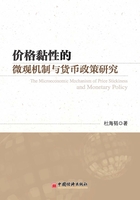
Abstract
Since the mid-1980s the debate on the business cycle in macroeconomics has been essentially between the sticky price and real business cycle varieties, given the demise of the new classical monetary models. However, a major concern of new Keynesian theorists has been to explain how nominal rigidities arise from optimizing behavior. The paramount task facing Keynesian theorists is to remedy the theoretical flaws and inconsistencies in the old Keynesian model. Therefore, new Keynesian theorists aim to construct a coherent theory of aggregate supply where wage and price rigidities can be rationalized.
The main contribution of this paper is building a standard DSGE model that fully accounting for pricing heterogeneity after carefully investigating the pricing behavior in micro price data from the Ministry of Commerce daily necessities market monitoring system. The calibration and estimation of this model has provided us with a panoramic view from which the macroeconomists can get an understanding of the pricing behavior with a multilevel, logical consistency and flexibility.
The first chapter investigates the pricing behavior in micro data and establishes some typical facts about prices in China's daily necessities.
(1)The weighted-mean frequency of price adjustment of all 39 kinds of goods is 18. 35 percent;the implied mean duration is 7. 59 weeks. The weighted-median frequency and duration are 13 percent and 1. 44 weeks, re-spectively.
(2)The weighted-mean size of price adjustment is 15. 72 percent.
(3)The mean fraction of increasing price is 52. 69 percent and that of decreasing price is 47. 31 percent.
(4)The monthly reference price abstracted from the weekly price data is about 2x slower than the week prices in the frequency. The first adjusts once 2. 96 months, the latter 1. 52 months. This shows that the variation in reference price captures most of the variation in prices that matters for macroeconomics, that is, most of the variation in prices reflecting the response to macroeconomic shocks. Deviations from reference prices tend to be transient, whereas macroeconomic shocks tend to be persistent.
(5)The pricing model of daily necessities in China's cities is time-dependent, because the intensive margin dominates the inflation, not the extensive margin.
(6)The results from simulation of a simple partial equilibrium model support the time-dependent pricing model in daily necessities.
The second chapter has analyzed price stickiness by estimating duration models at a much disaggregated level. The main results should be emphasized. First, the piecewise constant hazard model can fit the data better after accounting for the frailty. Second, Wald test has shown that 31 out of 39-type goods do not reject the null hypothesis, that is, there is strong evidence of time-dependence in daily necessities. Last, even taking into account the asymmetry of determinants of price increases and price decrease, there is still strong evidence supporting the time-dependence.
The third chapter fits an empirical distribution of price durations in micro data with power variance function distributions(PVT). The Log Hougaard Calvo pricing model can fully capture heterogeneity in daily necessities. I build a model in which there is a continuum of firms that set prices according to a Calvo mechanism, each of them with a possibly different price adjustment parameter. The simulation results of the model show that incorporating estimated heterogeneous pricing setting rules into a standard DSGE model is crucial to understanding inflation and output dynamics.
The final chapter documents shows the effect of macroeconomic and sectoral shocks by estimating a dynamic factor model using a large set of macroeconomic indicators and disaggregated prices. Our main finding is that disaggregated prices appear sticky in response to macroeconomic and monetary shocks, but flexible in response to sector-idiosyncratic shocks. The“price puzzle”of CPI has disappeared if estimating dynamic factor model using the much disaggregated price data compiled by me, however, that of PPI still remains. Moreover, the“price puzzle”of CPI and PPI both remain if using 118 sectoral price index released by National Bureau of Statistics of China.